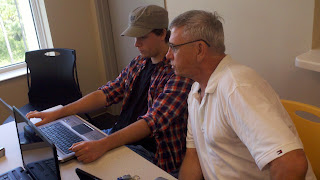They had no problems opening a Google account and following the detailed instructions I had provided for them using screen captures of the step-by-step process of uploading their Paper 2 drafts and getting to the Share link step of the process.
I soon discovered that this generation of learners do not like to follow directions; they prefer to figure it out themselves. With the exception of one student in the class who changed the access from "Can View" to "Can Edit", no one else clicked on the editing access box.
It was only after I got back to the office and opened the links to the papers did I notice that 99% of the papers were set to View Only. Alas.....now I know in the future to do the process with them or at least warn them to click on that finally button at the end of the directions for access to editing.
After doing this, they worked in their Peer Review teams to discuss a sample comparison-contrast paper I had found online comparing and contrasting two restaurants. The students used the Paper 2 rubric I had provided for them and each member was assigned a different criterion to use in the discussion. For example, one person might look at the organization and fluency of the essay. Another might look at the introduction, the thesis, and the conclusion. Another would discuss the grammar and mechanics of the paper.
You can find the link to that essay at www.roanestate.edu/owl/Mac.html.
After the small group discussion, we had a group critiquing discussion. When I asked the students what grade they would give the paper, the majority said a 'C' with a few saying the paper should be a 'B.' We went through the criteria on the rubric and began to knock off points for organization, lack of research and support, and all those problems with grammar and mechanics. The paper went from a 'B' or a 'C' to a 'D' after this lively discussion.
I was quick to point out that in an effective critique, it is important to mention the strong areas. We all decided we liked the writer's MLA first page format and the vivid description of Fox's Diner. We also liked that the writer had a clearly stated thesis.
We spent the next few minutes going over how to make changes in a Google document using the Insert....Comment feature. I wish I had had more time for discussing the paper and reading through the comments I had made on that paper the previous day. I did put the link to this paper with the comments in the discussion forum, but I seriously doubt that people will take the time to read the comments that I made.
Check out this video tutorial on using Google docs. from YouTube.
http://www.youtube.com/watch?v=FCJFgieFxfU&feature=related












